Alchemy and Natural Science – Part 4
By Dennis Klocek 15 min read
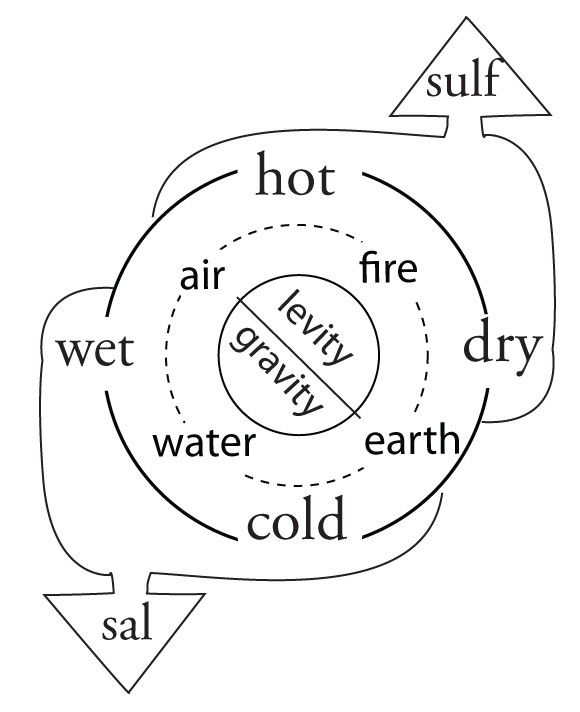
By contrast the use of levity / gravity alchemical relationships can serve as the basis for a systematic, mandalic approach to sequencing natural phenomena. This develops a reliable pictorial based research system available to anyone. Pictorial thinking can support the idea that the macro(species) and micro (hormones) levels of plant development are based on resonant universal patterns inherent at all levels, and in all organisms. Revealing the universal resonant patterns in organisms at all levels opens the door to forming research ideas that can link plant growth to human physiology in profound ways.
The ever evolving challenges of human health can not be solved by technical thinking about the life sciences. The language of a living, growing plant forms, as well as the human embryo is inherently pictorial. The basis for this present work is to show pictorial patterns shared between the molecular diagrams used today to depict plant chemistry and the changes happening in a growing plant form itself . A Lewis diagram for the chlorophyll molecule is an image of a flowering plant.
These formal patterns are inherently resonant in all living things at all levels of inquiry. The hope is that this series of essays will enable a non-scientific person to see more deeply into how medicinal plants interact with the human organism. Those who grow and love plants will find this series challenging but hopefully rewarding of effort.
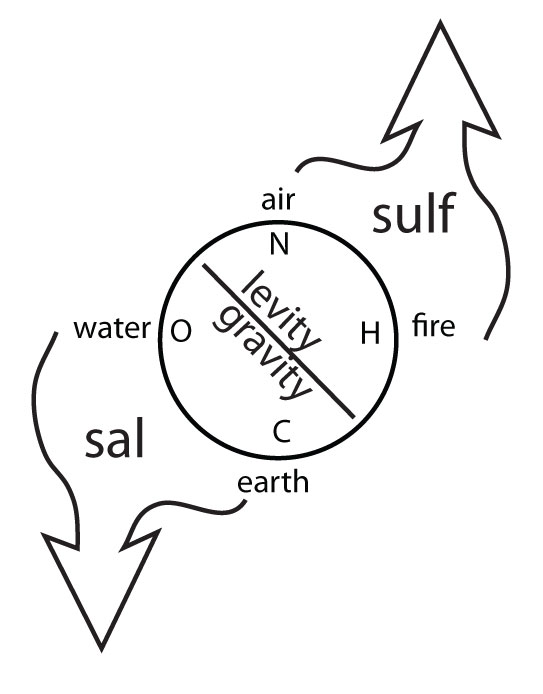
In a living plant the movement of sap depends upon a spectrum of reactive substances. The molecular movements of substances from root salts to seed oils is a series reciprocal transformations that at each step are an image of a whole flowering plant. These reactions are known as redox. This stands for reduction of oxygen (RED) and addition of oxygen(OX). Exchange of oxygen is the most reactive force in chemical changes. Alchemically degrees of reactivity can be represented by relationships to gravity and levity as the two fundamental forces that support life.
Oxygen and carbon have relationships to both gravity and levity. Potentials for fixing other substances found in carbon represent the power of gravity of the earth pole. But carbon is also deeply connected to the realm of levity by supporting combustive processes of warmth. Carbon then has a strong gravity force and a weak gravity force that can be written in a subscript system as C(Gg).
Since carbon has strong potential for double bonding this subscript could be written as C(GgGg). Hydrogen in this type of script can be written H(LL) to show that it is a source of strong levity forces with little connection to gravity. Oxygen, has a strong relationship to gravity (capital G) in oxidation processes. But it also has a clear relation to levity by being a gas. Oxygen both with strong gravity and weak levity occurs in pairs and can be written O(GlGl) with a double capital and small letter designation. This split quality comes to the fore when linked to carbon and hydrogen in the formation of sugars (carbohydrates). In carbohydrate formation of water soluble sugars, oxygen forms a reactive link between hydrogen and carbon.
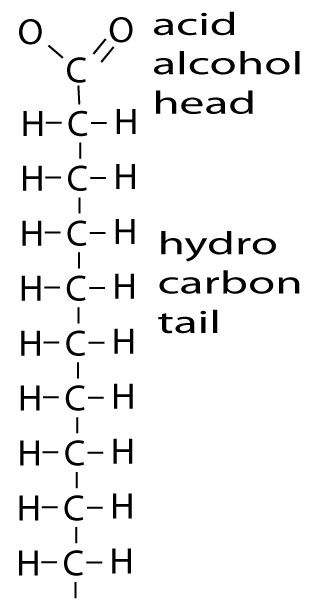
In oil soluble hydrocarbon formation the structure of fatty acids reveals a water loving head composed of an acid and an alcohol. This shows the presence of reactive oxygen. This is linked to a water avoiding tail of a hydrocarbon chain composed of carbon with abundant gravity force C(GgGg) linked to hydrogen that has much levity H(LL). These two are linked without the reactive forces of oxygen. Since carbon can be self bonding, a hydrocarbon can be written as HC(GgGgLL). This shows a potential for strong gravity and strong levity with possible bridges to levity.
In hydrocarbons, repeated patterns of carbon provide multiple potential points for the formation of compounds with hydrogen. Carbon forms a scaffold with hydrogen providing reactivity through levity, all along the scaffold. This manifests in the creation of a vast number of substances with a wide array of formations. Among the oils, fixed oils relate to the gravity pole being rich in carbon linkages they form polymer films.
Hydrocarbons are richer in hydrogen H(LL) and can also form gasses that are easily linked to substances. In structural inorganic chemistry these patterns lead to an immense and bewildering array of petroleum products derived from oil and gas each with its own molecular structure. The complexity of inorganic hydrocarbon molecules does not easily lead to insight about plants and their growth processes.
Organic hydrocarbons in plants are the source of fixed film oils, volatile essential oils and oil based phospholipids, the substances that form the cell membranes of all cells in nature. These chemical complexities make an understanding of general plant physiology difficult. The purpose of this article is to provide a much more simple way of looking at molecular structures that can be useful when imagining the role of substance transformation in the various seasonal phases of plant growth.

Plants shift from primarily water soluble acidic phenol compounds in early stages of growth to strongly oil soluble, water avoiding terpene substances at flowering and fruiting. The influence of minerals that guide these changes can be more easily understood when levity / gravity imaginations are used. The water avoiding lipids, are oils and fats made from long chains of fatty acids that plants evolve into terpenes when stressed. Fatty acids are fixed chains of hydrocarbons (fats and oils) rich with carbon C(GgGg) and hydrogen H(LL) with a water soluble head that contains oxygen O(GgGg) and phosphorus.
The hydrocarbons are the building blocks of oil production. Little reaction to water solvents happens in the long fatty tail of the hydrocarbon molecule. That is balanced by the oxygen found in an acidic, water loving, phenolic ring or head at one end of the hydrocarbon chain. Lipids are made from many forms of fatty acids. Being oily they are hydrophobic (water avoiding). Alchemically lipids are close to the fire element. They are oxygen O(GlGl) poor, and carbon C(GgGg) and hydrogen H(LL) rich.
Their sign for levity and gravity shows a strong middle division (GgGgLL). Strong gravity and strong levity linked to weak gravity. The fire is brought down by gravity and locked to the earth but the whole pattern is stable. In the most fundamental form of a fatty acid there is a water loving head formation that represents the link to oxygen and its manifesting dynamic.

The fixed plant oils have more carbon C(GgGg) that is linked to hydrogen H(LL) than other forms. The strong gravity forces of carbon form long chains that create polymerizing films. Hydrocarbons have much less oxygen than carbohydrates. Their gravity forces are dominated by carbon that results in a water avoiding oily quality. Being oily they are less reactive with water than sugars that benefit from the reactive activity of oxygen. The movement between less reactive conditions to more reactive conditions and back again is the fundamental gesture of the transformation of substances in a flowering plant.
Reactive substances oxidize/combust and in this volatility seek combination with other substances. Ultimately, any combining creates deposits of substances (ash). Ash is non volatile but the salts in the ash are water soluble. The release of levity in combustion is the doorway into gravity through ash production. Ash products when released in water release the salts they contain into solution. Salt solutions in the soil create a basis for growth towards future combustion.
In taking on oxygen from the environment substances become more complex, and the interaction is reactive. However in the fail/safe patterns of nature, strong reactive combining gradually reduces the potential for further reaction. At that point the flame goes out and the ash falls down. (“Ashes,ashes ; we all fall down”)
The taking on of oxygen is alchemically a gravity/ deposition or sal gesture, As more volatile substances react with other substances like oxygen they first move towards complexity, then a gradual move into levity until oxidation feeds a burning, volatile combustion that gradually produces less volatility.
Alchemically the end result is ash or fixedness. Fixedness characterizes the sal pole (deposition), volatility characterizes the sulf pole(combustion). Hydrogen H(LL) the lightest and most volatile element leads compounds into rarified levity states of dissolution. The exit of hydrogen produces no ash of itself. The ash formation that arises from combustion or oxidation is from previous salt processes and moves the reaction back towards gravity. This is the sal to sulf to sal cycle analog of the flowering process in plants.
Hydrocarbons as lipids often form a union with phosphorus, a mineral that is very reactive in seeking oxygen. The phosphorus brings oxygen to the hydrogen/ carbon structure of hydrocarbons (lipids). Together the phosphorus and the lipids create the universal cell wall compound, the phospholipid. Phospholipids form nano level cellular forms, micelles, composed of water avoiding (lipid) tails and water/oxygen loving (phosphorus) head structures.
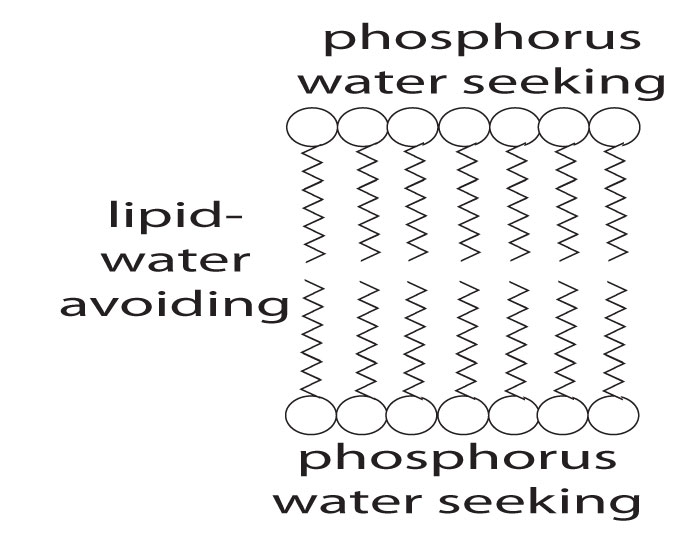
Phospholipids form when the oily, water avoiding hydrocarbon tails in aqueous solutions unite together to form a spherical form that puts the reactive water loving mineral and gaseous molecular heads on the outside of the sphere. The oil loving and the water avoiding molecular hydrocarbon tails join together on the inside. This incredibly minute structure is known as a micelle, a minuscule ball of oil surrounded by water. Micelles unite to create bilayer membranes when oxygen and phosphorus unite. This process universally forms cell membranes.
Cell membranes must simultaneously resist water and be permeable to water. All cell membranes are made of hydrocarbons (oils resist water), phosphorus (reacts with water) and proteins(gates). They regulate movements into and out of cells as the basis of nutrition.
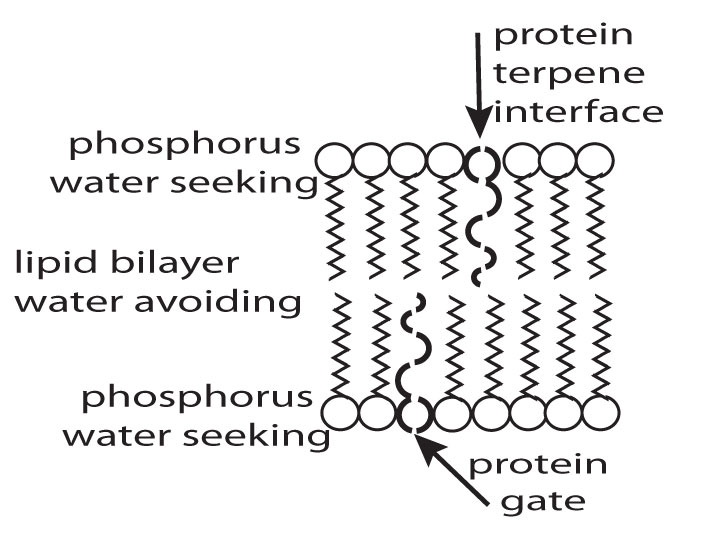
This image shows the phospholipid bilayer of a cell membrane that is universal in all living cells at all levels. The terpenes that compose essential oils have co-evolved with the cellular requirements of organisms. They serve to interact with the opening and closing of protein gates in the cell membrane. Chemically, the essential oils make the proteins in the gates more responsive.
These gates allow solutions necessary for nutrition to pass from one side of a cell membrane to the other. This terpene/protein regulated passage is the basis for all nutrition and excretion in organic systems. In this way terpenes regulate life.
Terpenes are combinations of very simple lipids. Their name has the same word root as turpentine, an oil. Terpenes form the basis for the powerful chemistry that produces essential oils as plants shift from growing to flowering. We could say a terpene is a congealed or grounded fire (carbon/earth C(GG) + hydrogen/fire H(LL).
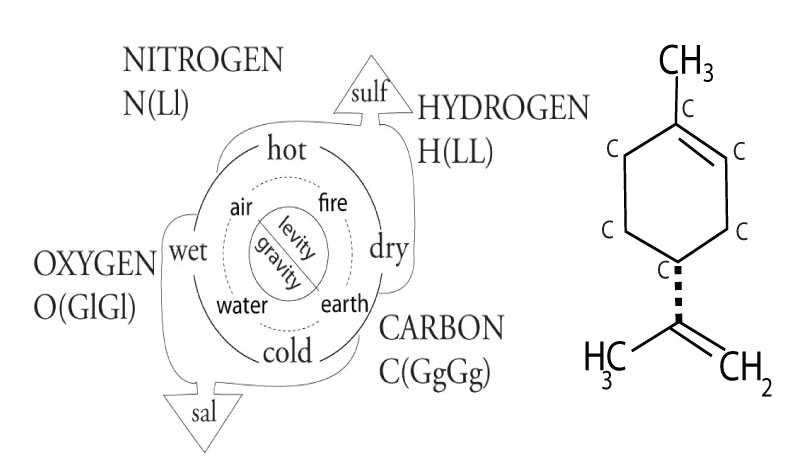
The image of the molecule shows a fundamental head and tail pattern present in chlorophyll. This is also an image of a plant with a flower on it. Terpenes have a strong attraction to oxygen due to the fact that, being hydrocarbons, they are oxygen poor. When terpenes interact with oxygen they become terpenoids, a remarkably vast realm of substances that are healing to organisms.
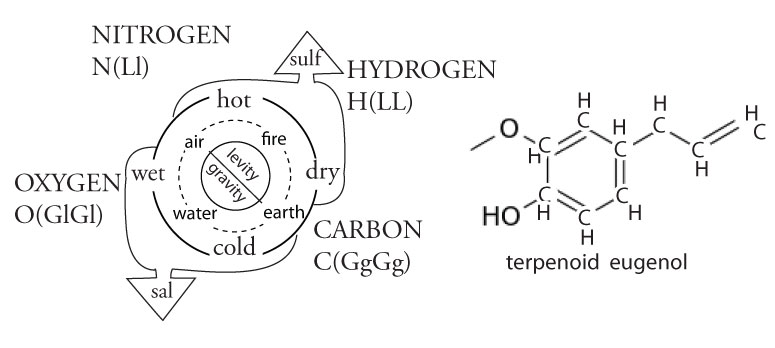
Terpenoids are formed when oxygen poor terpene hydrocarbons form oxidative bridging compounds known as terpenoids. The oily terpenes then become volatile. Oxygen O(GlGl) with its split levity/gravity forces moves the lipids out of the gravity pole and through reduction makes the resulting lipid more levity filled and volatile. Terpenoids have a relation to oxidation processes.
Oxidation processes create signals that are linked to stress events in life forms. The signals consist of enzymes and hormones that guide essential oil production. It is in this signaling of the terpenoids that essential oils come into their own. Essential oils are much more volatile than fixed oils. Their ring form is characteristic.
Alchemically terpenes and terpenoids would be placed in the sulf or sulfur pole opposite to the salts. Oxidation happens in plant physiology when chlorophyll degrades due to stress events. It might be good to see an image of the chlorophyll molecule to assess why the alchemical gravity/levity approach to plant chemistry is a useful way to look at these processes in plant chemistry.
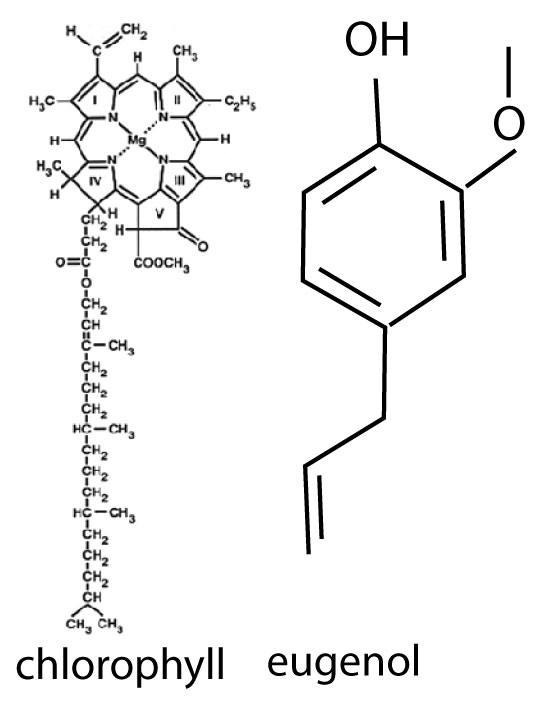
A form gesture very similar to the chlorophyll molecule can be seen in the terpenoid molecule. In the formal language, the gesture of the long carbon stalk and the ring of nitrogenous compounds in chlorophyll can also be seen in the hydrocarbon stalk and ring molecule. This same pattern can be seen in the stalk and inflorescence of a plant. These formal signatures are very resonant. In chlorophyll the energies are moving down and in the flowering plant the energies are moving up.
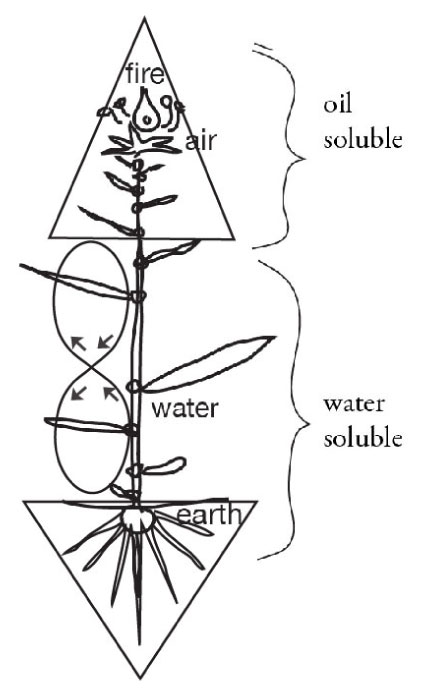
A plant going into flowering is moving from the earth into a more rarified state. As it does so it still is linked to the earth but is striving towards the light and warmth in its flower and seed production. The evolution from being fixed hydrocarbons into volatile hydrocarbons such as terpenoids, parallels the creation of essential oils. Oxidation of chlorophyll in a flowering plant releases free fatty acids and alcohols that serve as the basis for the formation of more complex terpenoids.
Terpenoids arise when the plant shifts from primary chlorophyll production in leaves to primarily chlorophyll metabolism that happens as it grows towards flowering. Terpenoids then become reactive in the formation of essential oils. An alchemist would say that the production of essential oils during flowering is a form of combustion. The plant is self immolating towards seed production. Terpenoids are created from oxidation present in chlorophyll breakdown processes.
These metabolic phases develop more complex molecules as the plant grows past vegetation into the approach to flowering. The terpenoids evolve into essential oils as a kind of “ash” forming pattern due to the combination with oxygen. An ash is a precipitate that is forming as levity of combustion comes under the influence of gravity.
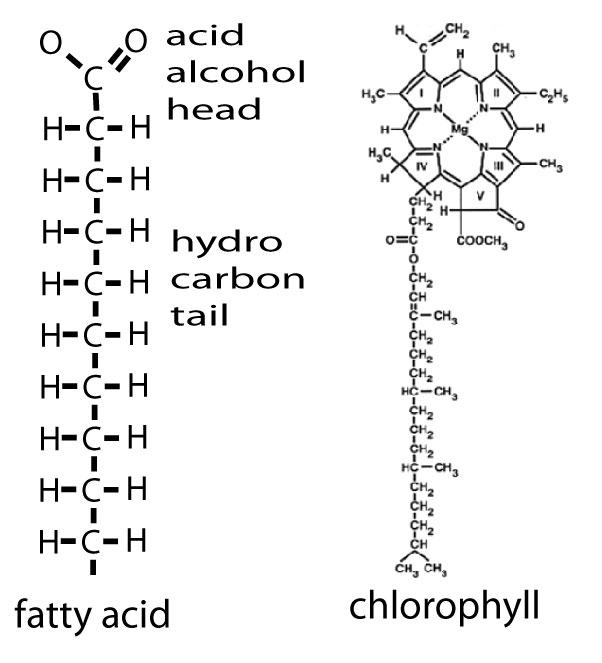
Chlorophyll breaks down to a fatty acid (hydrocarbon) and alcohol (oxygen introduced). Both acid and alcohol are water soluble but the fatty acid with long carbon chains is is a precursor to the formation of hydrocarbons in lipids. The alcohol being more reactive with the oxygen content causes reactions that release levity in combustion or metabolic processes.
Combining with oxygen, the fatty acids form into carbon and hydrogen rich terpenenoids that are the basis for essential oil formation. Terpenoids rich in carbon form into fixed oils. Those with even more gravity rich carbon C(GgGg) form into resins. An essential oil has more levity than a fixed oil but more gravity than an alcohol. An essential oil then could be seen as an “ash” of an alcohol. A fixed or film oil could be seen as an “ash” of an essential oil. A resin or cooked oil in this way of looking is an “ash” of a fixed oil.
Terpenoid forming activity is present in plants in the diurnal alternation between daytime chlorophyll anabolic production and night time chlorophyll catabolic breakdown. In annual plants this daily build up and breakdown of substances reaches a maximum seasonal fineness in the formation of anthers and pollen as the prelude to seed production. An alchemical term for pollen is “ash”. Pollen leads to seed formation and its chemistry. A seed in alchemical language is an ash. Research has shown that it is the seeds that control the degree of oxidation and metabolism of the more fixed substances in the plant sap. This control arises in the approach to the calyx and the flower above it and is the signature that the dominant mode is now terpenoid production.
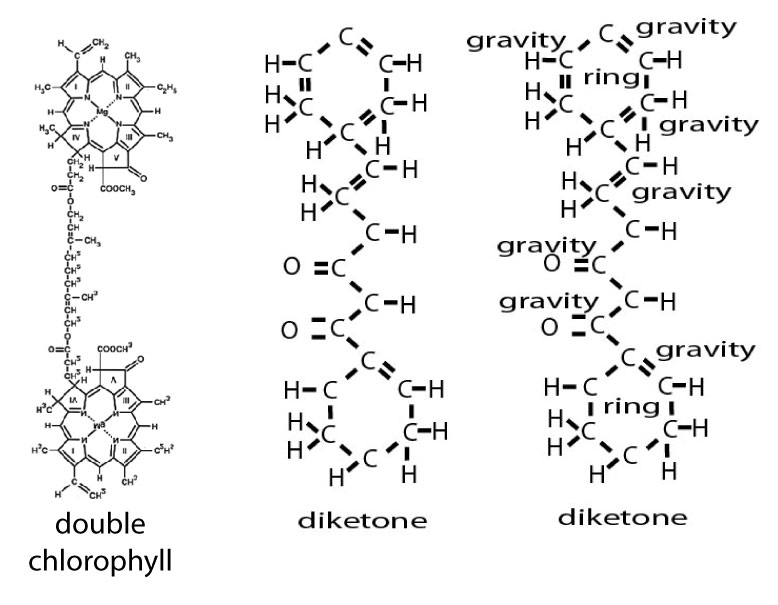
The breakdown and recombining of substances can give rise to even more complex molecular compounds such as flavonoids (pigments) that arise generally as seed protecting substances. The image compares a di-ketone with a natural double ring to a chlorophyll molecule that has been doubled. This is to illustrate the complex nature of a di-ketone that still adheres to the ring and tail motifs seen earlier.
The ash like products such as ketones contain many sites for enhanced oxidation and transformation through linkages to lipids, minerals and metals. Enhanced oxidation and combination with minerals makes these substances much more complex. The levity forces of warmth and light burn out the chlorophyll. Ketones and plant pigments fall out of this degradation as a kind of precipitate or “ash” of light as the plant gradually approaches seed production.
The breakdown of chlorophyll can also lead to acids and alcohols, that in combination are known as esters. This process is enhanced when the initial plant material has a strong chlorophyll content. Plants growing at low altitudes tend to have low chlorophyll content and plants from high altitudes tend to have high chlorophyll content. This is considered to be a result of stronger light chemistry (UV) at work on the plants at higher altitudes.
In summary, as the plant moves away from growth towards flowering the fluid nature of water soluble elements like esters is compromised through dehydration and sap restriction due to smaller organs. Esters can be thought of as switches that allow simple substances to become more complex and also for complex substances to become more simple. In summary, esters are the first links in a gradually more reactive chain of processes as chlorophyll is broken down in the approach to flowering.
Phospholipids from plant cell membranes are released as free fatty acids under the influence of ketones. Free fatty acids contribute to the formation of terpenes and terpenoids as more complex substances like essential oils and phenolic ketone pigments are produced to protect the embryos. Terpenoids are the most diverse form of organic substances in plants. They contribute aromas and in combination with esters create specialized fragrant alcohols like geraniol or nerol. The alcohols interact with oxygen in an increased respiration as flowering develops. This accompanies diminished growth in favor of the reproductive inflorescence.

Dennis Klocek
Dennis Klocek, MFA, is co-founder of the Coros Institute, an internationally renowned lecturer, and teacher. He is the author of nine books, including the newly released Colors of the Soul; Esoteric Physiology and also Sacred Agriculture: The Alchemy of Biodynamics. He regularly shares his alchemical, spiritual, and scientific insights at soilsoulandspirit.com.
Similar Writings
Rediscovering the Sacredness of Nature: Interview with Dennis Klocek
Dennis Klocek is an artist, scientist, teacher, researcher, gardener, and alchemist. He lives and works in Sacramento, California and is Director of the Consciousness Studies Program at the Rudolf Steiner College in California. He has been a great inspiration for many people over the years and has given workshops and talks on a variety of…
The Moral Roots of the Climate Crisis
This is the last chapter in “The Harmonies of Storms” Dennis’ PDF eBook on the Music of the spheres; Harmony in climate change. In his widely acclaimed movie, An Inconvenient Truth, Al Gore concludes that the climate crisis is in reality a moral crisis. Just what does that mean? How is morality, traditionally a soul…
